Taxonomy
|
Scientific Name:
Kingdom: Plantae
Division:
Class: Coniferae (cone bearing) Family: Pinaceae (Pine Family)
Genera: Picea (Spruce)
Species: mariana English Name(s):
Black Spruce,
First Nation Names:
ts'iivii
|
Description
|
Structure:
- A distinguishing charactaristic is the pubescent (hairy) branchlets.
- Lower branches often drooping.
- Uppermost branches often in a tight cluster forming a dense crown.
- usually small tree, up to 7-15 meters.
Leaves:
- Needle like, short, 1-2 cm long.
Reproductive Parts:
- Female cones broadly egg-shaped to nearly sperical, purpleish.
- Female cones remain on the tree for several years. Often forming tight masses in tree tops.
- Male cones dark red, maturing brown, and falling off.
Seed:
Not to Be Confused With:
- P. glauca is the only other spruce in our area. P. glauca can be distinguished by its larger cones and lack of hairs on the twigs between the leaves (needles).
|
Biology
|
Physiology:
- After forest fires the seeds in the cones often survive. They are then released onto the fresh burned ground.
- Can reproduce vegitatively by layering.
- One theory for the tight crown at the top of P.mariana is that squirrels clip off the cone laden branches as high as they can efficiently work leaving the very highest.
- Will grow in shrub form at or near treeline.
Life Cycle:
- Perennial
- Seed cones (female) persisting on the tree for several years.
Seasonal Cycle:
|
Ecology
|
Animal Uses:
- Squirrels harvest the cones from the tree. They will store them or they will eat the seeds out of them right away.
Habitat:
- Dominant tree in lowland muskegs.
- Tolerant of wet poorly drained sites and soils.
|
Uses
|
Modern:
Industrial:
- P.mariana in not often harvested for lumber because of its small size.
- Because Black Spruce grows so slowly it is ussually very dense and makes for good fire wood.
- Green branches can be used as a sleeping mat when camping.
- Spruce beer is made from the young growing tips in the spring.
- The long fibers in the wood make for great paper. It is harvested comercially for paper pulp.
- The crews travelling with Captain James Cook recieved a ration of spruce beer every other day to prevent scurvy.
Medicinal:
- Spruce salve is long lasting and is said to have all the healing properties of the raw sap but is easier to apply.
- Spruce salve is made by mixing animal fat or vaseline with equal amounts spruce sap in warm water when it is all liquid of even consistency it can be poured in a bottle, cooled and used when needed.
Food:
- The young branchlets can be steeped in boiling water to make a tea high in vitamin C.
Traditional Gwich'in:
Folklore:
Industrial:
- Dead branches used as fire starter.
- Green branches were used as flooring in tents.
- Outer bark was used for making smoke houses. The bark was harvested in the spring.
- Roots were used for rope, string, and for sewing the rims of baskets, skins, and birch bark boats.
- Wood was used for many things; log houses, smoke houses, caches, stages, tool handles, and sleds.
Medicinal:
- Branches are sometimes boiled with the cones to make the medicinal tea.
- Chewing the young spruce tips is good for an itchy throat and for any kind of flu or cold.
- Cones are collected and boiled to make a tea. The longer they boil the stronger the medicine becomes. The tea is taken to relieve coughing and sore throats.
- Inner bark was chewed on to relieve colds or to maintain good health. It could also be applied to wounds as a bandage and aided in healing. It could be dried for storage and reconstituted when needed.
- Old sap can be used to draw out slivers by applying a mix of pitch and salve over the sliver.
- Sap called 'sticky gum' is used to sooth irritated skin and when applied to cuts it helps healing and protects from infection.
Food:
- Old sap called 'spruce gum' is chewed like gum and used to be given to the kids as a treat.
Traditional Other:
Folklore:
Industrial:
- Spruce pitch boiled and mixed with ash was used by different tribes as a seem sealer on canoes and other things.
- The bark has been used as shingles and as flooring.
- Trappers cleaned the human smell of traps by boiling the traps in water with spruce branches, alder twigs and bees wax. This protected from rusting as well.
Medicinal:
- Some tribes made a powder from spruce needles and dusted it on burns blisters and cuts.
- Spruce pitch or salve was applied to cracked soles of ones foot.
- The Chapewyan boiled young spruce cones to make a mouth wash for treating infections, toothache, sore throats and for cleaning phlegm from the throat.
- The Chipewyan wrapped dry rotted spruce wood in a cariboo hide pounded it to a podwer. Then used the powder as baby powder preventing chaffing and acting as a deoderant.
- The Dene treated snow blindness and eye scratches by spliting small twigs heating them and extracting the sap. A birds quill was used to apply this warm substance to the eye.
Food:
|
|
Images
|
|
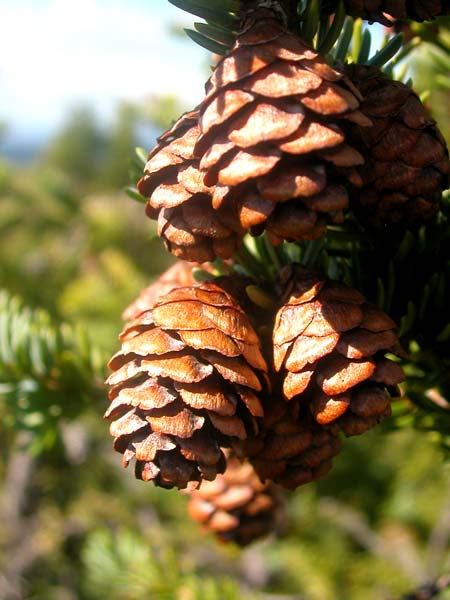
Seed cones

Decumbent shrub-like form at treeline. Note the immature berry looking cones.
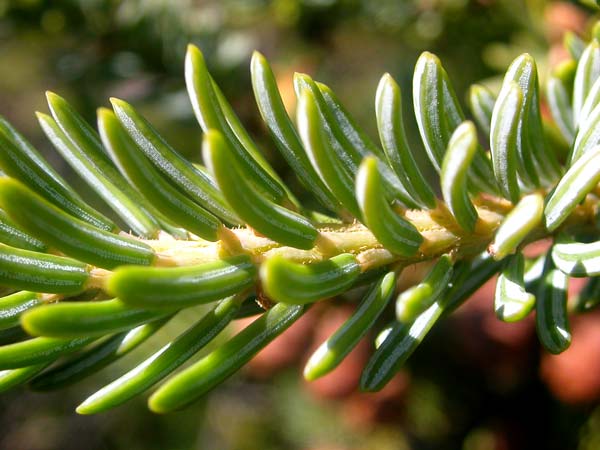
Look for the hairs between the leaves (needles)
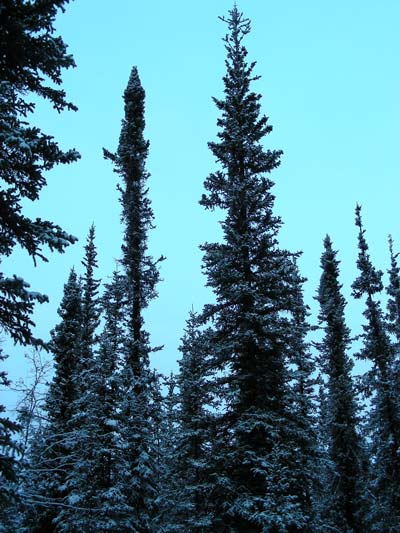
P.mariana (Black Spruce) right P.glauca(White Spruce) left.
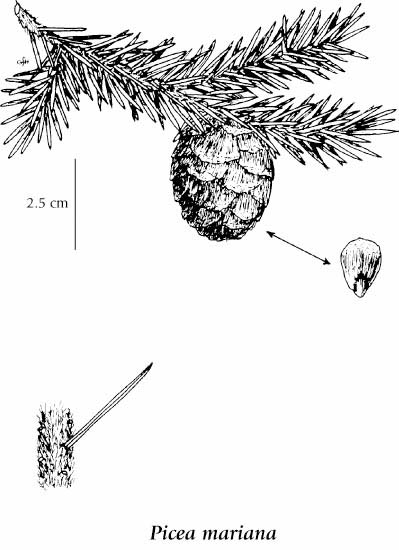
Illustration from: Illustrated Flora of BC |
Range Maps
|
|
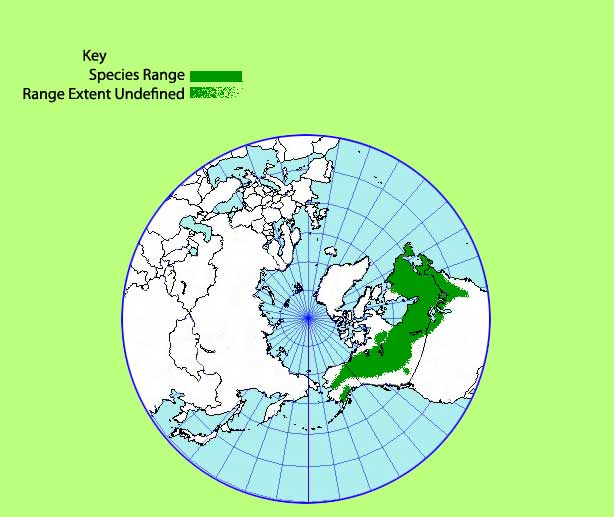
World Range: Boreal North America from NL & LB to BC and AK.
Prov/State Abrev. List
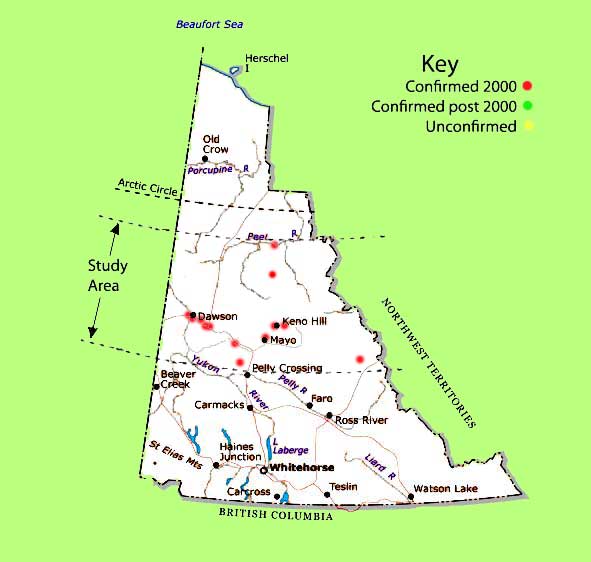
In Yukon: North to the Porcupine Valley |
|






